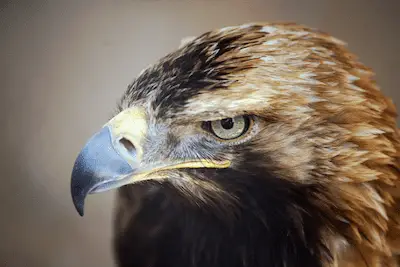Spanish Imperial Eagle
(Aquila adalberti)
The Spanish Imperial Eagle, also called Spanish Eagle, is one of the rarest birds of prey in the world, with currently about 500 breeding pairs making up the entire global population.

Along with other highly vulnerable raptor species in Europe (including the Saker Falcon and the Bearded Vulture), the Spanish Imperial Eagle is a symbol of endangered nature that needs our help in order to ensure its survival.
But the good news is that strict protection and conservation efforts saved the Spanish Imperial Eagle from going extinct in the 1970’s, when the population was down to 30 breeding pairs at its lowest point.
This success shows that if we commit ourselves to helping our raptors with a range of different conservation measures, we can achieve amazing results, and it’s essential that we build on this progress.
Spanish Imperial Eagle facts
As a large European raptor species, the Spanish Imperial Eagle is unmistakable if you get a chance to see it on the wing. However, due to its rarity, it has become increasingly difficult to watch this beautiful eagle in the wild.
Spanish Imperial Eagle size
The Spanish Imperial Eagle is a large eagle species that is slightly smaller than a European Golden Eagle.
- Wingspan: 180-210 cm
- Length: 77-82 cm
- Weight: 2,800-3,500 g (female), 2,400-2,900 g (male)
When compared to the Eastern Imperial Eagle, the Spanish Imperial Eagle is slightly smaller, though the distribution ranges of the two species don’t overlap, which means you don’t need to worry about confusing them in the field.
Appearance
The Spanish Imperial Eagle is a large, strong eagle that is dark brown in coloration (adults) or light brown (juveniles). Adults have a distinct white border on the front edge of their wings, which makes them easy to identify.

Sexual dimorphism
Similar to most eagle species breeding in Europe, female Spanish Imperial Eagles are larger than males, though this difference isn’t as pronounced as with other raptor species.
Lifespan
A maximum age of 40 years has been recorded in captivity.
Scientific name and taxonomy
The scientific name of the Spanish Imperial Eagle is Aquila adalberti. In the past it was considered to be a subspecies of the Eastern Imperial Eagle (Aquila heliaca), but DNA analysis has revealed that the two are distinct species that are part of a superspecies.
Apart from the Eastern Imperial Eagle, the closest relative of the Spanish Imperial Eagle in Europe is the Steppe Eagle (Aquila nipalensis).
Spanish Imperial Eagle distribution
The Spanish Imperial Eagle is only found on the Iberian peninsula, as well as a few locations in Morocco, though the latter are only used as wintering grounds of immature birds. Occasionally, individual birds are encountered far away from their breeding grounds, in central Europe, for example.
Spanish Imperial Eagle habitat
The Spanish Imperial Eagle favours woodlands interspersed with open areas, although it is also found in marshes and wetlands in some areas. It is most common in areas with large populations of rabbits, which are one of its main food sources during the breeding season.
Spanish Imperial Eagle population size
The entire population of Spanish Imperial Eagles is estimated to be between 400 and 500 pairs, which is the lowest number of breeding pairs of any raptor found in Europe. Indeed, the Spanish Eagle is one of the rarest raptor species in the world. This, together with its restricted breeding range, means that intense conservation efforts are essential to ensure its continued survival.
Spanish Imperial Eagle behavior
The Spanish Imperial Eagle likes to hunt by soaring and slowly flying over open countryside or along hillsides, and stoops down rapidly when it detects prey out in the open.
Feeding and diet
The most important food source of the Spanish Imperial Eagle are rabbits, which can make up more than 90% of its diet during the breeding season. However, pairs nesting in marshy regions or wetlands, take mostly waterfowl such as geese, ducks, and coots. Outside of the breeding season, juveniles are often encountered in wetlands, where they also feed on waterfowl.
Breeding
The Spanish Imperial Eagle builds a large stick nest in old trees, and rarely also on electric pylons. The female lays 1-4 eggs, which are incubated for up to 42 days. After hatching, the young eagles stay in the nest for up to 75 days, and after they fledge they continue to be fed for several weeks.
Similar to many other species of large raptors, the young eagles often practice cainism, in which the oldest chick kills and eats the younger ones. However, if food is plentiful, this happens less frequently.
Spanish Imperial Eagle migration
Spanish Imperial Eagles are largely sedentary, although juvenile eagles move around over long distances, and even cross the Gibraltar strait into Morocco. Juvenile Spanish Eagles also show up in wetlands where there is a plentiful supply of water birds.
Spanish Imperial Eagle conservation status
The Spanish Imperial Eagle was almost driven to extinction due to relentless persecution, with a total of just 30 breeding pairs recorded in 1970. However, the species has since made a steady recovery, and there are now up to 200 breeding pairs in the Iberian Peninsula.
Due to the small population size and restricted breeding range, the conservation status of the Spanish Imperial Eagle is classified as “Vulnerable” by BirdLife International. It’s essential to continue conservation efforts at the fullest extent, as well as to monitor this species closely, to ensure any potential threats are detected as early as possible.
It’s very encouraging to see that the population size of the Spanish Imperial Eagle has increased over the past two decades, but this trend must be continued in order to ensure the survival of this species.
Threats
The main threat to the Spanish Imperial Eagle during the last century was the destruction of habitat due to changes in agriculture, which caused a decline in rabbit populations in many regions.
Currently, the biggest threat is electrocution on power lines and pylons. This can definitely be avoided by making power lines safe for birds, and this needs to be implemented in all parts of the Iberian Peninsula.
Finally, Spanish Eagles are also vulnerable to poisoning, due to the fact that they readily take carrion, and some individuals are killed this way every year.
Additional resources:
- Greater Spotted Eagle migration patterns
- Lesser Spotted Eagle size
- White-tailed Eagle conservation status
